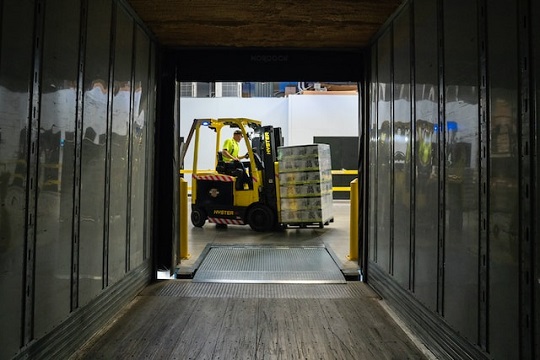If you’re looking to streamline your supply chain operations, cut costs, and boost overall productivity, you understand that efficient warehouse management is crucial. You can make a significant impact by planning a well-thought-out warehouse layout and incorporating advanced technologies and strategic practices.
In this blog post, we’re here to guide you through the top 10 best practices for warehouse management. We’ll walk you through everything, from designing your layout to implementing continuous improvement strategies.
Before we go further into this topic, don’t forget to follow my LinkedIn account. You’ll get more helpful insights on supply chain management there.
Table of Contents
Efficient Layout Design
In the intricate dance of warehouse management, your layout design serves as the linchpin, shaping the efficiency and functionality of your entire operation.
An optimized layout is more than just a spatial arrangement; it’s a meticulous orchestration of storage zones, workstations, and aisles that intricately interweave to enhance your operational fluidity. Your paramount goal is to minimize your travel time because it directly impacts the speed at which your orders are fulfilled.
By strategically placing high-demand items in proximity to your shipping areas, you can expedite the order fulfillment process and meet your customer expectations for swift deliveries.
Furthermore, your thoughtful organization of storage based on product velocity ensures that your frequently accessed items are easily accessible, reducing retrieval time and contributing to an overall increase in productivity.
In essence, your layout becomes a roadmap for efficiency, streamlining processes, and maximizing space utilization to create a harmonious and agile warehouse environment.
The symbiosis between your efficient warehouse layout and streamlined processes is crucial for businesses like yours navigating the complexities of inventory management. Your well-thought-out design not only minimizes logistical hurdles but also acts as a catalyst for improved order fulfillment efficiency. Every square foot optimized for functionality is a resource unlocked, enhancing your warehouse’s capacity to meet demand seamlessly.

It is the art of balancing accessibility and storage capacity, creating a dynamic space that adapts to the weight and flow of your inventory demands.
As your aisles become pathways for progress and storage areas transform into strategic hubs, your warehouse evolves into a finely tuned machine, maximizing the utility of available space and ensuring that every step taken within its limits is purposeful.
In essence, your layout design is the silent conductor orchestrating a symphony of efficiency within your warehouse’s bustling confines.
Inventory Classification through ABC Analysis
Implementing an ABC analysis is like having a strategic compass in the complex landscape of inventory management. This classification system, named after the first three letters of the alphabet, helps you categorize items based on their significance, allowing for a nuanced approach to their management.
Your Class A items, representing the crème de la crème in terms of importance, typically consist of high-value and high-priority products. Although they may be a minority in terms of quantity, these items wield significant influence over your overall operations.
By assigning these items a distinct classification, you can tailor your management strategies to ensure meticulous attention and frequent monitoring. This focused approach helps you allocate resources judiciously, directing increased scrutiny and operational efficiency toward safeguarding the availability and quality of your Class A items. As a result, the ABC analysis becomes a strategic tool, guiding you to prioritize your efforts where it matters most and strengthening your ability to meet market demands with precision.
In the dynamic realm of supply chain orchestration, the ABC analysis not only streamlines resource allocation but also acts as a safeguard against potential disruptions. By categorizing items based on their inherent value and significance, you can create a tiered system that aligns with the varying demands of different products. This classification empowers you as decision-makers to devise tailored strategies, ensuring that high-priority items are managed with the attention they deserve.

Moreover, the ABC analysis serves as a preemptive measure against stockouts and inefficiencies. Through advanced categorization, you can ensure the critical items that warrant careful monitoring, preventing shortages that could lead to missed opportunities or dissatisfied customers.
In essence, the ABC analysis transcends mere inventory management; it becomes your strategic compass, guiding you to navigate the intricate terrain of supply chain dynamics with foresight and precision.
You might also like:
- Top 10 Causes of Inventory Inaccuracies You Need to Be Careful Of
- Top 10 Inventory Management Best Practices
Real-time Tracking with Advanced Technologies
In the intricate dance of supply chain management, accurate inventory tracking emerges as the heartbeat that sustains optimal operations. The delicate balance between maintaining sufficient stock levels and averting stockouts or overstock situations hinges on the precision of your tracking methodology.
When you harness the power of advanced technologies such as Radio-Frequency Identification (RFID) or barcoding, you revolutionize inventory management by giving yourself a real-time window into the dynamic movements of goods within your warehouse.
This level of visibility ensures not only accuracy in recording inventory levels but also empowers you with timely and actionable data.
The immediacy of real-time tracking transforms your decision-making processes, offering you up-to-the-minute insights into stock levels and their precise locations, allowing you to navigate the intricate supply chain landscape with agility and foresight.
The adoption of advanced tracking technologies represents a paradigm shift in the way businesses like yours manage their inventory, transcending traditional methods and manual processes.
RFID, with its ability to wirelessly transmit data and track items without direct line-of-sight, and barcoding, with its cost-effective simplicity, emerge as potent tools in your arsenal of inventory control.
By eliminating the delays and inaccuracies associated with manual tracking, these technologies create a seamless flow of information, ensuring that you are equipped with the most current and reliable data.

This newfound transparency not only minimizes the risk of stockouts, which can lead to missed sales opportunities and customer dissatisfaction, but also mitigates the challenges of overstock situations, preventing the accumulation of excess inventory that can strain your financial resources.
In essence, accurate inventory tracking, facilitated by cutting-edge technologies, is the linchpin that empowers you to navigate the intricate supply chain landscape with precision and confidence.
Effective Demand Forecasting
Demand forecasting emerges as a cornerstone in your strategic arsenal of warehouse management, providing you with a forward-looking lens into the intricate dance of supply and demand.
Your ability to accurately predict future inventory needs is instrumental in maintaining a delicate equilibrium between supply chain efficiency and cost-effectiveness.
Through effective forecasting techniques, you gain the foresight necessary to align your stock levels with anticipated demand, preventing the perilous scenarios of stockouts or excess inventory.
This proactive approach not only safeguards against missed sales opportunities and dissatisfied customers but also contributes to a leaner and more responsive supply chain.
The collaboration between your warehouse management, sales, and marketing teams becomes paramount in this endeavor, as the accurate gathering of demand data serves as the lifeblood of forecasting accuracy.
By fostering a symbiotic relationship among these key stakeholders, you can enhance your predictive capabilities, ensuring that your inventory is poised to meet market demands with precision and agility.
In the dynamic landscape of modern commerce, where consumer preferences and market trends can shift rapidly, effective demand forecasting is a linchpin for your success.
Beyond the prevention of stockouts and excess inventory costs, accurate forecasting acts as a catalyst for overall supply chain efficiency. It allows you to optimize procurement, manufacturing, and distribution processes, aligning each element of your supply chain with the anticipated demand curve.
This synchronization not only minimizes the risk of financial losses associated with holding excess inventory but also contributes to a more sustainable and customer-centric business model.

As technology continues to evolve, the integration of advanced analytics and artificial intelligence into demand forecasting processes further refines your predictive accuracy, offering you a competitive edge in navigating the complexities of the ever-changing market landscape.
In essence, effective demand forecasting transcends mere inventory management; it becomes a strategic imperative that propels you toward a future-ready and resilient supply chain ecosystem.
Order Picking Optimization
At the heart of your streamlined warehouse operation lies the pivotal process of order picking, where optimization becomes the linchpin for efficient order fulfillment.
The intricacies of this process necessitate your strategic approach to minimize delays and maximize productivity. Organizing pick paths, the routes you and your team take to gather items for orders, is a fundamental step in this optimization journey.
By strategically mapping out paths that minimize your travel time and reduce unnecessary backtracking, you can significantly enhance the efficiency of your order picking operations.
Moreover, the implementation of batch picking methods, where multiple orders are fulfilled simultaneously by a single picker, adds another layer of efficiency.
This not only reduces the overall time spent traversing your warehouse but also increases the throughput of your orders, contributing to a more agile and responsive fulfillment system.
In the age of digital transformation, software solutions play a transformative role in optimizing your order picking process. Advanced systems that leverage real-time order data and inventory locations provide a dynamic framework for route optimization.
These software solutions analyze your live data streams, adapting picking routes on the fly to accommodate changes in order priorities or inventory locations.
The result is a highly responsive and adaptive order picking operation that aligns seamlessly with the evolving demands of your warehouse.
By harnessing the power of technology to streamline your order picking process, you not only reduce operational costs associated with labor and time but also elevate the overall efficiency of your order fulfillment, creating a competitive edge in the fast-paced landscape of modern commerce.
You might also like:
- Decoding SOP Discipline: A Close Look at How Managers Keep the Supply Chain in Check
- Unveiling the Hidden Costs: The Impact of Meaningless Actions on Waste in Supply Chain Management
Cross-Docking Strategies
Cross-docking stands as a strategic beacon in the realm of logistics, offering you an expedited and streamlined approach to the movement of goods within your warehouse.
This logistics strategy involves the swift transfer of products directly from the inbound receiving area to outbound shipments with minimal to no storage time.

The essence of cross-docking lies in its ability to eliminate the need for prolonged warehousing, reducing your handling costs, and expediting the flow of goods through your supply chain.
By minimizing the time products spend in storage, you can significantly cut down on operational expenses associated with space utilization and labor, creating a more cost-effective and agile system.
This approach is particularly advantageous for your fast-moving and perishable goods, where time sensitivity is paramount. The immediacy inherent in cross-docking ensures that these time-critical items reach their destination quickly, reducing the risk of spoilage and helping you meet market demands with unparalleled efficiency.
The efficacy of cross-docking extends beyond cost savings, making it a valuable strategy for optimizing your supply chain dynamics.
By bridging the gap between your inbound and outbound logistics seamlessly, cross-docking minimizes lead times and enhances your overall responsiveness.
This strategy is particularly well-suited for industries where just-in-time inventory management is crucial, allowing you to synchronize your production and distribution processes with market demand.
As the e-commerce landscape continues to evolve, cross-docking has become a linchpin for fulfillment centers, enabling them to fulfill your orders rapidly and maintain a competitive edge in the ever-accelerating pace of the modern marketplace.
In essence, cross-docking serves as your logistical accelerator, propelling goods from receiving to shipping with unparalleled speed, efficiency, and adaptability.
Employee Training and Safety
In the intricate dance of warehouse management, your investment in employee training emerges as a non-negotiable cornerstone for creating a workplace that is both safe and efficient.
Your well-trained warehouse staff is the backbone of a smooth-running operation, and this begins with a deep understanding of safety protocols.
From the operation of heavy machinery to the handling of materials, thorough safety training is paramount to mitigating risks and preventing accidents.
Equipping your warehouse employees with the knowledge and skills to navigate their work environment safely not only safeguards their well-being but also contributes to the overall efficiency of your warehouse operations by minimizing disruptions caused by accidents or injuries.

Beyond safety protocols, employee training extends to the mastery of equipment operations and the adoption of efficient warehouse practices.
Your professionally trained staff can operate machinery with precision, reducing the likelihood of errors and enhancing productivity.
Regular training sessions, whether focused on new technologies or optimized workflows, act as a continuous improvement mechanism, ensuring that your employees stay abreast of industry best practices and evolving technologies.
As a result, your investment in employee training becomes a dual-purpose initiative, fostering a culture of safety while simultaneously bolstering the skillset and adaptability of your workforce.
The ripple effects of this investment are felt throughout your warehouse, translating into increased productivity, reduced downtime, and an overall workplace environment that prioritizes both efficiency and employee well-being.
Supplier Collaboration for Efficient Procurement
The symbiotic relationship between you and your suppliers plays a pivotal role in the overall efficiency of your warehouse management.
Fostering strong connections with your suppliers is not merely a transactional necessity but a strategic imperative. Enhanced communication and collaboration with your suppliers create a more synchronized and responsive supply chain.
By cultivating robust relationships, you can streamline your procurement processes, ensuring a seamless flow of goods from your suppliers to your warehouse.
This not only reduces the administrative burden associated with procurement but also minimizes lead times, enabling you to maintain optimal stock levels and meet customer demands efficiently.
The real-time exchange of information between you and your suppliers becomes a catalyst for agility, allowing your business to adapt swiftly to fluctuations in demand and supply.
In the realm of strategic collaboration, the implementation of Vendor-Managed Inventory (VMI) systems stands out as a transformative tool.
VMI goes beyond traditional supply chain dynamics by placing a greater degree of responsibility on your suppliers to manage and replenish the inventory at your warehouse.
This not only increases visibility into stock levels but also promotes a higher degree of coordination between you and your suppliers.

With real-time data on inventory levels and product demand, VMI facilitates proactive decision-making, allowing your suppliers to anticipate restocking needs and you to maintain optimal stock levels without the traditional back-and-forth of ordering.
The result is a more streamlined and efficient supply chain where the collaborative efforts of you and your suppliers are orchestrated seamlessly to ensure a steady and responsive flow of inventory.
You might also like:
- Winning in Supply Chain: Competence and Attitude Matter Most
- How Your Personality Affects Your Performance in Supply Chain Management
Warehouse Automation Technologies
The advent of warehouse automation technologies represents a paradigm shift in the landscape of efficient warehouse management. Embracing technologies such as robotics, automated guided vehicles (AGVs), and conveyor systems heralds a new era of increased efficiency, accuracy, and speed in various warehouse operations.
These automated systems excel in handling routine and repetitive tasks, including picking, packing, and transporting goods, liberating you from mundane responsibilities.
By offloading these routine functions onto automated systems, you can redirect your efforts toward more complex and value-added activities, such as strategic decision-making, quality control, and process optimization.
The synergy between your intelligence and machine precision results in a dynamic and responsive warehouse ecosystem that is both efficient and adaptable to the evolving demands of modern commerce.
Automation not only revolutionizes the speed and precision of warehouse operations but also serves as a catalyst for error reduction and cost efficiency.
Robots and AGVs, guided by advanced algorithms and sensors, can navigate warehouse environments with remarkable accuracy, minimizing the likelihood of errors in tasks like picking and packing.
The precision of automated systems contributes to a reduction in order fulfillment errors, enhancing customer satisfaction and loyalty.
Additionally, the deployment of automation leads to notable cost savings by reducing labor costs associated with routine and manual tasks.
As warehouses increasingly integrate automation into their operations, they position themselves at the forefront of a transformative wave that not only augments efficiency but also reshapes the role of human workers, empowering them to contribute their skills in more strategic and innovative capacities.
Continuous Improvement Strategies
In the dynamic realm of warehouse management, the pursuit of excellence is an ongoing journey that hinges on your commitment to continuous improvement.
Regular assessment and refinement of warehouse processes serve as the compass guiding you toward operational excellence.
By leveraging performance metrics, employee feedback, and industry best practices, you gain valuable insights into the efficacy of your operations and areas that warrant enhancement.

This data-driven approach empowers you as decision-makers to identify inefficiencies, address bottlenecks, and implement strategic improvements that align with your evolving business goals.
The essence of continuous improvement lies not only in reacting to challenges but proactively seeking opportunities to optimize workflows, enhance productivity, and stay ultimately ahead of the competition.
Cultivating a culture of continuous improvement within the warehouse is more than a strategic choice; it is a cornerstone for resilience in the face of dynamic market demands.
This cultural shift fosters an environment where employees are encouraged to contribute ideas, share insights, and actively participate in the refinement of processes.
By involving the workforce in the improvement journey, you tap into a collective intelligence that is attuned to the nuances of daily operations.
The adaptability instilled by a continuous improvement culture ensures that your warehouse remains agile in responding to changing market demands and technological advances.
In essence, your commitment to continuous improvement becomes a competitive advantage, propelling your warehouse toward operational excellence and future-proofing its place in the competitive landscape.
Conclusion
Navigating the complexities of efficient warehouse management demands a comprehensive and integrated strategy.
When you incorporate the top 10 best practices outlined, ranging from optimizing layout design to integrating advanced technologies and committing to continuous improvement, you create a holistic framework for your warehouse environment.
This approach ensures that your warehouse is not only well-organized but also streamlined and highly productive.
The strategic placement of high-demand items, the implementation of ABC analysis for inventory classification, and the adoption of real-time tracking technologies collectively contribute to minimizing your travel time, reducing errors, and ensuring accurate inventory management.
This, in turn, translates into tangible cost savings and enhanced operational efficiency.
Beyond the immediate operational benefits, optimizing warehouse management has broader implications for your business.
The ripple effects of a well-organized and efficient warehouse extend to improved customer satisfaction and a distinct competitive edge in the market.
Timely order fulfillment, a byproduct of effective order picking optimization and cross-docking strategies, contributes to customer delight by meeting delivery expectations. Meanwhile, the integration of automation technologies enhances accuracy and speed, further elevating the customer experience.
In a landscape where customer expectations are ever-evolving, your optimized warehouse not only caters to operational needs but becomes a cornerstone for building a resilient and customer-centric supply chain.
As you increasingly recognize the strategic importance of efficient warehouse management, embracing these best practices positions you not only for internal efficiency gains but also for a strategic advantage that resonates throughout your entire supply chain ecosystem.
I hope you find it helpful!
Please share this article with your colleagues so they can also benefit. For more insights on supply chain management, follow my LinkedIn account. You’re free to use all articles on this blog for any purpose, even for commercial use, without needing to give credit.

 by
by 

